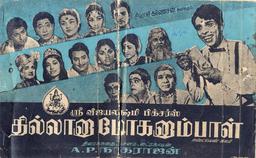Director: A.P. Nagarajan; Producer: A.P. Nagarajan; Cinematographer: K.S. Prasad; Editor: Rajan, T.R. Natarajan; Cast: Sivaji Ganesan, Padmini, T.S. Balaiah, A.V.M. Rajan, K. Balaji, M.N. Nambiar, Nagesh Babu, K.A. Thangavelu, T.R. Ramachandran, Chittor V. Nagaiah, S.V. Sahasranamam, K. Sarangapani, E.R. Sahadevan, A. Karunanidhi, P.D. Sambandam, Manorama, C.K. Saraswathi, Udaya Chandrika, Shanmuga Sundari, Ambika, M. Saroja, M.L. Bhanumathi, Kalpalatha, S. Ramarao, Sendamarai, M.K. Murthy, Kallapart Natarajan, Balasundaram, Gundu Karuppaiah, T.N. Sivathanu, Chandran Babu, S.R. Dhasarathan, S.V. Rajagopal, Siva Suryan, A.M. Marudhappa, Lakshmi
Duration: 02:45:54; Aspect Ratio: 1.311:1; Hue: 17.478; Saturation: 0.084; Lightness: 0.377; Volume: 0.179; Cuts per Minute: 7.848
Summary: A major hit celebrating nostalgia, set in the Kaveri delta in TN, the nursery of many dance and music traditions, the plot features a musical contest and love story between dancer Mohanambal (Padmini) and the nadaswaram player Sikkil Shanmugha- sundaram (Ganesan). The love story, overcoming many hurdles presented mainly by the dancer’s mother and her rich suitor Nagalingam (Balaji), reaches a happy ending and the couple bids farewell to the audience from the wedding dais when ‘tradition’, so crucial to Nagarajan’s neo- traditionalism, has been valorised. Although the film claimed to represent ‘classical’ art, using noted nadaswaram players Sethuraman and Ponnuswamy dubbing the hero’s performances, and Padmini in probably her most elaborate Bharat Natyam film performance, its aesthetics are borrowed mainly from the commercial theatre with a mise en scene using mostly frontal shots, even lining up the characters to deliver their lines facing the camera. A major song hit was Nallamdana (sung by P. Susheela). Nagarajan, a former TKS Brothers employee, pays tribute to Sankaradas Swamigal (a major theatrical figure from whom the TKS group traced its ancestry) by naming a drama company after him and providing cameo roles for many old stage actors (Balaiah, K. Sarangapani, Chittor V. Nagaiah, M.N. Nambiar, S.V. Sahasranamam, E.R. Sahadevan, P.T. Sambandham, K.A. Thangavelu and A. Karunanidhi). References to the courtesan tradition, horse- drawn carriages and palaces suggest a 19th C. setting, but contemporary images of Madurai and Thanjavur railway junctions belie this. Similarly, actual locations are mixed in with a fictional town, Madanpur, ruled by an achkan- clad king with a Western wife, turning the entire film into a fantasy scene.
Song Book:

Indiancine.ma requires JavaScript.